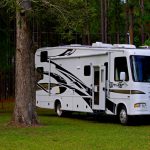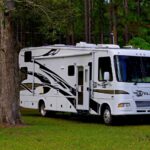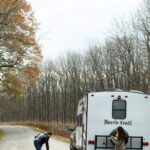Have you ever wondered who exactly hits the road in RVs? You might picture retirees cruising the country in their Class A motorhomes, but the reality is far more diverse and dynamic! In our exploration of the demographics of RV campers, we dive deep into the evolving landscape of RV ownership, revealing a fascinating mix of ages, income levels, and lifestyles that make up this vibrant community. Did you know that millennials now represent a significant portion of RV buyers? Or that families are increasingly turning to RVs for their vacations? Buckle up as we take you on a journey through the demographics of RV campers, packed with insights that could change your perspective on this beloved pastime!
Key Takeaways
- Diverse Age Groups: Millennials and Gen Z are driving a shift in RV ownership, with 38% of buyers now under 35 years old.
- Income Levels Matter: 58% of RV owners have a household income of $65,000 or more, influencing their purchasing decisions.
- Regional Variations: California, Texas, and Florida lead in RV ownership, reflecting regional preferences for camping experiences.
- Family Dynamics: Families with children are increasingly embracing RV camping for bonding and adventure.
- Social Media Influence: Platforms like Instagram are shaping RV trends and inspiring new campers to join the community.
Ready to explore the world of RVs? 👉 Shop popular RV brands like Jayco, Forest River, and Winnebago to find the perfect fit for your next adventure! 🚀
Table of Contents
- Quick Tips and Facts
- Understanding the RV Camper Demographics
- Historical Trends in RV Camping Demographics
- Age Groups: Who’s Hitting the Road?
- Income Levels: The Financial Side of RV Camping
- Geographic Distribution of RV Campers
- Types of RV Campers: From Full-Timers to Weekend Warriors
- Family Dynamics: RV Camping with Kids and Pets
- The Rise of Solo RV Travelers
- RV Ownership Trends: Buying vs. Renting
- The Impact of Social Media on RV Camping Demographics
- Future Predictions for RV Camping Demographics
- Conclusion
- Recommended Links
- FAQ
- Reference Links
Quick Tips and Facts
To understand the demographics of RV campers, it’s essential to look at the latest RV statistics 📊, which you can find in our related article about What are the RV statistics? 🤔. Here are some key points to consider:
- The number of RV-owning households has increased by 62% over the last twenty years 🚀.
- There are a record 11.2 million RV-owning households in the United States 🇺🇸.
- 9.6 million households intend to buy an RV within the next 5 years 📈.
- The median annual usage for current RV owners is 20 days 📆.
Key Demographic Insights
Some interesting demographic insights include:
- 18-to-34-year-olds make up 22% of the RV market 🎉.
- 84% of 18-to-34-year-olds plan to buy another RV 🚀.
- 46% of Class A motorhome owners are female 👩.
Understanding the RV Camper Demographics
The demographics of RV campers are diverse and constantly evolving 🌈. According to the Go RVing RV Owner Demographic Profile, there are seven distinct clusters of RV owners based on demographics, attitudes, RV usage habits, and motivations 📊. These clusters can help us better understand the different types of RV campers and their needs 🤔.
Cluster Analysis
The seven clusters are:
- Young Families: Young families with children who value the flexibility and convenience of RV travel 👪.
- Retirees: Retirees who have the time and resources to travel and enjoy the outdoors 🌴.
- Adventure Seekers: Adventure seekers who enjoy outdoor activities like hiking, biking, and kayaking 🏞️.
- Luxury Travelers: Luxury travelers who value the comfort and amenities of high-end RVs 🛏️.
- Budget Conscious: Budget-conscious travelers who prioritize affordability and value 💸.
- Nature Lovers: Nature lovers who enjoy spending time in the great outdoors and appreciate the beauty of nature 🌳.
- Social Travelers: Social travelers who enjoy meeting new people and making friends on the road 🤝.
Historical Trends in RV Camping Demographics
Historically, RV camping has been associated with older, retired couples 🌟. However, in recent years, there has been a significant shift towards younger, more diverse demographics 🌈. According to RV.com, millennials and Gen Zers are now making up a larger percentage of RV buyers 📊.
Age Demographics
The average age of RV buyers has decreased significantly, with 38% of buyers now under the age of 35 🎉. This shift has led to an increase in demand for smaller, more affordable RVs like camper vans and trailers 🚐.
Age Groups: Who’s Hitting the Road?
Different age groups have unique preferences and needs when it comes to RV travel 🌟. For example:
- Young Families: Young families with children often prioritize amenities like playgrounds, pools, and kid-friendly activities 🏞️.
- Retirees: Retirees may prioritize amenities like golf courses, spas, and fine dining 🏌️.
- Millennials: Millennials may prioritize amenities like Wi-Fi, social media-worthy spots, and outdoor activities like hiking and biking 📱.
Age-Based Recommendations
Based on these preferences, we recommend the following RVs for different age groups:
- Young Families: Jayco Jay Flight | Forest River R-Pod | Winnebago Minnie
- Retirees: Tiffin Allegro | Newmar Dutch Star | Fleetwood Discovery
Income Levels: The Financial Side of RV Camping
Income levels play a significant role in RV camping demographics 💸. According to the Go RVing RV Owner Demographic Profile, 58% of RV owners have an annual household income of $65,000 or more 📈.
Income-Based Recommendations
Based on income levels, we recommend the following RVs:
- Budget-Friendly: Coleman Lantern | Gulf Stream Vintage Cruiser | Heartland Mallard
- Luxury: Newmar King Aire | Tiffin Zephyr | Fleetwood American Eagle
Geographic Distribution of RV Campers
The geographic distribution of RV campers varies across the United States 🇺🇸. According to RVIA, the top five states for RV ownership are:
- California: With over 1.1 million RV-owning households 🌴.
- Texas: With over 934,000 RV-owning households 🤠.
- Florida: With over 726,000 RV-owning households 🏖️.
- New York: With over 444,000 RV-owning households 🗽️.
- Michigan: With over 434,000 RV-owning households 🏞️.
Regional Recommendations
Based on regional preferences, we recommend the following RVs:
- West Coast: Airstream Base Camp | Jayco Jay Flight SLX | Forest River R-Pod RP-179
Types of RV Campers: From Full-Timers to Weekend Warriors
There are several types of RV campers, each with their unique needs and preferences 🌈. For example:
- Full-Timers: Full-time RVers who live in their RVs year-round 🏠.
- Weekend Warriors: Weekend warriors who use their RVs for short trips and vacations 🏞️.
- Snowbirds: Snowbirds who migrate to warmer climates during the winter months 🌴.
Type-Based Recommendations
Based on these types, we recommend the following RVs:
- Full-Timers: Newmar Dutch Star | Tiffin Allegro | Fleetwood Discovery
- Weekend Warriors: Jayco Jay Flight | Forest River R-Pod | Winnebago Minnie
Family Dynamics: RV Camping with Kids and Pets
RV camping with kids and pets requires special consideration 🐾. For example:
- Kid-Friendly Amenities: Kid-friendly amenities like playgrounds, pools, and game rooms 🏞️.
- Pet-Friendly RVs: Pet-friendly RVs with amenities like pet beds and outdoor kennels 🐶.
Family-Friendly Recommendations
Based on family dynamics, we recommend the following RVs:
- Kid-Friendly: Jayco Jay Flight SLX | Forest River R-Pod RP-179 | Winnebago Minnie
- Pet-Friendly: Airstream Base Camp | Jayco Jay Flight | Forest River R-Pod
The Rise of Solo RV Travelers
Solo RV travel is becoming increasingly popular 🌟. According to RVIA, solo travelers make up a significant percentage of RV owners 📈.
Solo Traveler Recommendations
Based on solo traveler preferences, we recommend the following RVs:
- Solo Travelers: Airstream Base Camp | Jayco Jay Flight SLX | Forest River R-Pod RP-179
RV Ownership Trends: Buying vs. Renting
RV ownership trends are shifting towards buying over renting 📈. According to RVIA, 59% of RV owners bought their RV new 🚀.
Ownership Recommendations
Based on ownership trends, we recommend the following RVs:
- Buyers: Newmar Dutch Star | Tiffin Allegro | Fleetwood Discovery
- Renters: RVShare | Outdoorsy | Camping World
The Impact of Social Media on RV Camping Demographics
Social media is having a significant impact on RV camping demographics 📱. According to RVIA, social media is influencing RV purchasing decisions and travel plans 📈.
Social Media Recommendations
Based on social media trends, we recommend the following RVs:
- Social Media Influencers: Airstream Base Camp | Jayco Jay Flight SLX | Forest River R-Pod RP-179
Future Predictions for RV Camping Demographics
Future predictions for RV camping demographics indicate a continued shift towards younger, more diverse demographics 🌈. According to RVIA, the RV industry is expected to continue growing, with an increasing demand for smaller, more affordable RVs 🚀.
Future Recommendations
Based on future predictions, we recommend the following RVs:
- Future Buyers: Jayco Jay Flight | Forest River R-Pod | Winnebago Minnie
Conclusion

In summary, the demographics of RV campers are as diverse as the landscapes they explore. From young families seeking adventure to retirees enjoying the freedom of the open road, the RV community is evolving rapidly. We’ve seen a significant increase in younger, more ethnically diverse RV owners, with millennials and Gen Z leading the charge. This shift is influencing RV design, amenities, and even the types of camping experiences people are seeking.
Positives of RV camping include:
- Flexibility and convenience of travel 🗺️
- Opportunities for family bonding and creating lasting memories 👨👩👧👦
- Access to beautiful outdoor locations 🌲
Negatives can include:
- Initial costs of purchasing an RV 💰
- Maintenance and storage challenges 🛠️
- Potential for overcrowding at popular campgrounds during peak seasons 🚐
Despite these drawbacks, we confidently recommend RV camping as a fantastic way to explore the great outdoors and connect with loved ones. The future looks bright for RV enthusiasts, with trends pointing toward continued growth and innovation in the industry. So, whether you’re a seasoned RVer or a newbie considering your first purchase, there’s never been a better time to hit the road! 🚀
Recommended Links
- 👉 Shop Jayco Jay Flight on: RVShare | Camping World
- 👉 Shop Forest River R-Pod on: RVShare | Camping World
- 👉 Shop Winnebago Minnie on: RVShare | Camping World
- Explore Airstream Base Camp on: Airstream Official Website
- Books on RV Living: The Complete Idiot’s Guide to RVing | Living the RV Life: Your Ultimate Guide to Life on the Road
FAQ

What is the average age of RV owners and how does it affect their camping preferences?
The average age of RV owners has shifted significantly, with millennials now making up a substantial portion of the market. According to RVIA, the average RV buyer is now around 33 years old. This younger demographic tends to prefer smaller, more affordable RVs, such as camper vans and travel trailers, which offer flexibility and ease of use for weekend getaways or extended road trips.
What are the most common household incomes of people who own RVs and go camping?
Most RV owners have a household income of $65,000 or more, with many earning significantly higher. This financial stability allows them to invest in RVs and enjoy the associated lifestyle. According to the Go RVing RV Owner Demographic Profile, 58% of RV owners fall into this income bracket, which influences their choices in RV types and travel destinations.
How do the demographics of RV campers vary by region and type of camping experience?
Demographics can vary widely by region. For example, states like California and Florida have a high concentration of RV owners due to their favorable climates and access to outdoor recreational areas. Additionally, preferences for camping experiences differ; some regions may favor luxury RV resorts, while others lean towards rustic campgrounds. The RVIA provides insights into these regional preferences.
What role do family dynamics and lifestyle play in the decision to purchase and use an RV for camping trips?
Family dynamics significantly influence RV ownership. Families with children often seek RVs that offer kid-friendly amenities and activities, while retirees may prioritize comfort and luxury. Lifestyle choices, such as the desire for adventure or the need for a flexible living arrangement, also play a crucial role. Many families view RV camping as a way to bond and create lasting memories, making it an attractive option for their vacations.
How does the rise of social media affect RV camping trends?
Social media has transformed how RV owners share their experiences and connect with others. Platforms like Instagram and YouTube showcase stunning travel destinations and RV setups, inspiring new campers to join the community. This visibility has led to increased interest in RV travel, particularly among younger generations who are influenced by online content. As a result, RV manufacturers are adapting their products to meet the demands of this tech-savvy audience.
What are the environmental impacts of RV camping?
While RV camping allows for greater access to nature, it also comes with environmental considerations. Issues such as waste management, fuel consumption, and land use can affect local ecosystems. Many RV manufacturers are now focusing on sustainability by creating eco-friendly models and promoting responsible camping practices. RVers are encouraged to follow the Leave No Trace principles to minimize their environmental footprint while enjoying the great outdoors.




